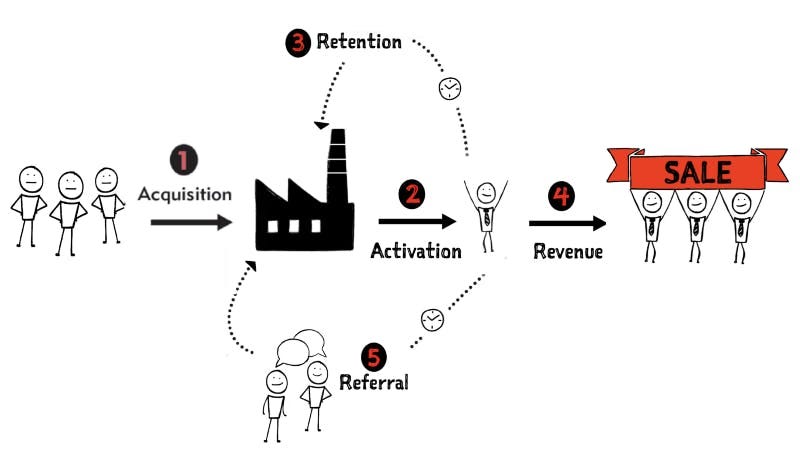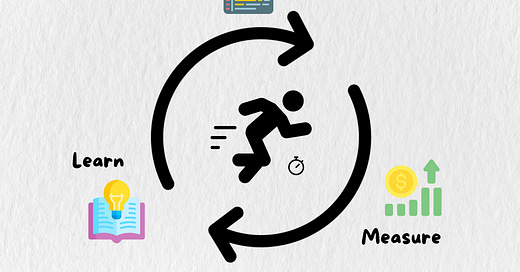Interpreting Software Engineering Work into Business Value: Lean Startup Basics
How Software Developer can leverage Lean Startup to shift to the Product Engineering
The time has changed for engineers. We can no longer focus only on building but ignore business growth metrics. As more businesses are chasing revenue, engineers need to think beyond code and understand how our work impacts business growth.
In the guest post today, Max Piechota walks us through Lean Startup principles, a great way to tie your engineering work directly to revenue growth. He’ll even show you how a simple improvement, like optimizing a landing page, could be worth $25,000/month to the business.
Curious? Let’s dive in 😄
Let’s Start: Software Engineers Need to Know How to Drive Business Growth
I am skeptical about AI replacing programmers. I defend the thesis that the basics of software craftsmanship will always be important, even when working with LLMs. If you don't know them, you’re better off sticking to no-code/low-code solutions. Software craftsmanship is not just about coding; it’s about much more, and it will always hold value.
However, it is obvious that the way software engineers work is going to change. Since it is becoming easier to generate good code, we no longer need to spend as much time typing it (of course, the art of working with LLM-generated code is a whole new skill in itself). As a result, we have more time to focus on more important tasks: business analysis, design, architecture, and more.
To do these things the right way, we need to understand how they drive the business.
The emerging idea is the Product Engineer role, and Lean Startup provides the perfect foundation to dive in this direction.
What if you could prove to your manager that your work contributed $25,000/month in revenue growth to the business? Sounds interesting? Read the article to learn how you can do this.
What is Lean Startup
Short Cycle Time to Gather User Feedback
Lean Startup is a methodology developed by Eric Ries, based on his experiences as a software developer and entrepreneur. While building IMVU, he struggled with the traditional approach of long development cycles and full-featured launches before receiving real customer feedback—often leading to failure. Through experimentation, he found that rapid, iterative development and early user validation reduced risk and improved product-market fit. His insights were further validated when advising startups and corporations, where he observed the same pattern: businesses spent months or years building products without testing assumptions, leaving little room to pivot when they failed.
This led to the creation of Lean Startup, centered around the Build-Measure-Learn loop. Companies develop a minimum viable product (MVP), test it with users, gather feedback, and use that data to refine their direction. By prioritizing learning over blind execution, businesses can optimize resources and build products that truly meet customer needs.
Note that regardless the name, it does not just apply to the startups. In fact, every new initiative, even in enterprise grade companies, is just a startup. That's why this methodology applies to most of the products we are working on.
Minimal Waste, Rapid Experimentation, and Continuous Learning
Lean Startup is a methodology for building products and businesses with minimal waste, rapid experimentation, and continuous learning. It helps companies avoid the traditional, high-risk approach of fully developing a product before testing whether customers actually want it.
At its core, Lean Startup is about validated learning—systematically testing assumptions about a product, market, or business model before committing significant resources. Instead of relying on guesses, teams use real-world experiments to discover what works and what doesn’t.
The Core Principles of Lean Startup
1. Build-Measure-Learn Loop – Instead of spending months or years developing a full product, companies should build a Minimum Viable Product (MVP)—the simplest version of the idea that allows for learning. This MVP is tested with real users, data is gathered, and decisions are made based on actual feedback.
2. Validated Learning – Every product decision should be treated as a hypothesis to be tested. If an idea doesn’t perform as expected, teams pivot (change direction) or persevere (refine and improve the idea).
3. Pivot or Persevere – If an experiment reveals that an assumption was wrong, instead of continuing down a failing path, the company should adjust (pivot) its approach to something more promising.
4. Innovation Accounting – Instead of using vanity metrics (e.g., number of downloads), Lean Startup focuses on actionable metrics that measure actual customer engagement and product success.
The topic is very broad and it can't be all described in this short article. Eric Ries described the foundations in his book The Lean Startup. His podcast provides lot more insights and ideas coming from the Lean Startup approach. It even includes ideas about efficient management of the software teams effort.
Be Empowered to Calculate Your Impact on the Business Revenue
For software developers, Lean Startup is not just a business strategy—it has direct implications for their daily work.
In the emerging AI-driven era, it is more critical than ever for software developers to engage deeply in product experimentation. Developers who understand business and product fundamentals can challenge assumptions, propose better solutions, and ensure that engineering efforts are solving the right problems. A good developer doesn’t just implement features—they question whether a feature truly moves the needle on the most pressing business risks.
The Growth Factory: A Systematic Approach to Product Growth

The Growth Factory is a framework that treats customer growth as a structured, measurable system. Just like a well-optimized factory, a product should efficiently acquire, convert, and retain users while minimizing churn. The key to sustainable growth lies in continuously improving the factors that drive this system.
At a high level, the growth formula is:
Net Growth=(Acquisition×Activation×Conversion)+Recommendations−Churn
Each part of this formula represents a stage in the customer lifecycle, and software developers play a critical role in optimizing them.
To illustrate this, let's take a simplified example with numbers:
Example: Monthly Growth Breakdown
Imagine a SaaS company with the following monthly metrics:
1,000,000 visitors to the website
2% conversion rate (visitor → free trial user) → 20,000 free trial users
20% activation rate (trial users → actively using the product) → 4,000 active users
25% conversion rate (active users → paying customers) → 1,000 paying customers
$50 average revenue per user (ARPU)
5% monthly churn rate (customers leaving)
Revenue Calculation:
$1,000 paying customers×50 (ARPU)=50,000 USD/month$
How Software Developers Impact Growth
Now, let’s see what happens if developers improve just one factor—the landing page speed, increasing the visitor-to-trial conversion rate from 2% to 3% (by optimizing load times, reducing friction, etc.).
New monthly numbers:
1,000,000 visitors
3% conversion rate → 30,000 free trial users
20% activation rate → 6,000 active users
25% conversion rate → 1,500 paying customers
$50 ARPU
5% churn rate
New Revenue Calculation:
$1,500×50=75,000 USD/month$
That’s an increase of $25,000/month just from improving one factor! If developers also optimize onboarding, retention strategies, and referral mechanisms, the compounding effect can lead to even greater revenue gains.
Imagine how would your yearly performance assessment look like if you could prove your contribution to the business with such data.
Example Ideas on How You Can Improve the Individual Factors
1. Acquisition (How do users find the product?)
Definition: The process of attracting new users to sign up, visit, or try the product.
How Developers Can Impact It:
Optimize landing page performance (faster load times = higher conversion rates).
Improve SEO and discoverability (structured metadata, indexing, API integrations).
Implement tracking for acquisition sources (UTM parameters, referral attribution).
Enable seamless integrations (SSO, embeddable widgets) to reduce friction in sign-ups.
2. Activation (Do users experience value quickly?)
Definition: Ensuring that users reach a key milestone (e.g., completing onboarding, using a core feature).
How Developers Can Impact It:
Design frictionless onboarding flows (progressive disclosure, interactive tutorials).
Implement feature flags to test different activation strategies without full releases.
Provide meaningful error handling and feedback to prevent early drop-offs.
Track and analyze user session recordings to identify onboarding pain points.
3. Conversion (Do users pay or take key actions?)
Definition: The process of turning free users into paying customers or achieving business-critical actions (e.g., booking, purchasing).
How Developers Can Impact It:
A/B test pricing models and checkout flows to improve conversion rates.
Implement data-driven paywalls (e.g., usage-based upsells, limited free features).
Optimize payment integrations (reduce friction in transactions).
Enable behavioral nudges (e.g., personalized offers based on user activity).
4. Retention (Do users keep coming back?)
Definition: Keeping users engaged and ensuring they continue to use the product over time.
How Developers Can Impact It:
Improve performance and reliability (slow apps lead to churn).
Implement usage reminders (e.g., push notifications, email triggers).
Analyze drop-off points using feature usage tracking.
Build habit-forming features (gamification, personalized recommendations).
5. Recommendation (Do users refer others?)
Definition: Users promoting the product through word-of-mouth or referral programs.
How Developers Can Impact It:
Build referral systems with seamless sharing (e.g., referral codes, easy invite flows).
Implement social proof mechanisms (e.g., user reviews, testimonials, case studies).
Optimize viral loops (e.g., rewarding users for inviting friends).
Enable integrations with social platforms for easy sharing.
6. Churn (Do users leave, and why?)
Definition: The percentage of users who stop using or paying for the product.
How Developers Can Impact It:
Implement exit surveys to capture churn reasons and address common pain points.
Track usage trends to detect disengagement early (e.g., reducing feature usage).
Optimize customer support channels (e.g., in-app chat, automated issue detection).
Enable win-back campaigns (e.g., re-engagement emails, special offers for inactive users).
Be the Growth Enabler in Your Team
A good software developer doesn’t just write code—they help optimize the Growth Factory by identifying bottlenecks and leveraging data-driven improvements. By integrating growth principles into engineering decisions, developers can reduce waste, prioritize impactful work, and build features that truly move the business forward.
To begin integrating product growth into your daily work, there are a few key action points that will set you on the right path. While becoming a full growth enabler is a long-term goal, here are some immediate steps you can take:
Understand customer factory metrics: Start by familiarizing yourself with key customer lifecycle metrics (acquisition, activation, conversion, retention, churn, recommendations).
Ensure metrics are being measured: Check if the necessary metrics are already tracked in the product. If not, take action to introduce the right tools and infrastructure to collect these data points.
Demand metric goals with feature requests: When new features are requested, always ask for the corresponding metric goals. Ensure that every feature aligns with business objectives and contributes to growth.
Last Words
Really appreciate Max for sharing his insights. Remember to check out his newsletter Business-value Driven Developer.
Thank you for reading the post!
❤️ Click the like button if you like this article.
🔁 Share this post to help others find it.
Resources
Tokyo Tech Lead is a blog/newsletter for engineering leaders. Check out this overview guide for all the resources it provides.
Guest Post Opportunities
If you are interested in writing for Tokyo Tech Lead, check this guideline post, and let’s build something together!
Contact
You can find me on LinkedIn or Substack.
If you want more content like this, consider subscribing to my newsletter.
See you in the next post!








Thanks for this piece Max and Adler.
I’m not sure if this applies to all developers in a team, but at least the tech lead should keep an eye on this.